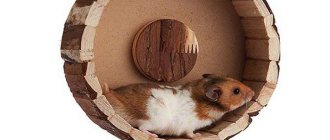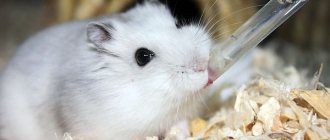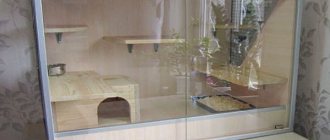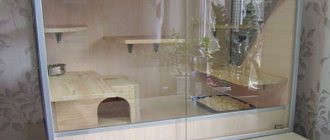- home
- Housing
03.11.2018 Toys for hamsters are essential items. The health of these restless, fussy animals is inextricably linked with physical activity. In order for your little pet to spend his leisure time beneficially “for body and soul,” you should make sure that the hamster has a sufficient number of interesting toys. Many sports and entertainment devices are presented in pet supply stores. But if their price does not fit into the owner’s budget, in order not to leave the animal without joy and a reason for training, you can make useful toys for the hamster with your own hands.
Hamster toys
Hamsters living in the wild are constantly on the move. They are forced to look for food, run away and hide from enemies. For domestic animals there is no need for this - there is food, there are no attacks from predators. But a life of safety and prosperity does not relieve hamsters of the need for activity. In order for your pet not to become “fat” and to remain vigorous and healthy, it is necessary to provide him with proper leisure time. The best option is active games. Special devices are designed to help organize them.
Toys for animals should be focused on finding treats and movement. These tasks can be either combined in one multifunctional device or distributed among different devices - monofunctional.
The first include devices containing “hard-to-get” treats. To get to a tasty prize, the hamster will have to try hard - run, rummage, climb, etc. These are any structures where you can hide a treat for the furry champion. Even stairs are included in this category, as the prize can be placed on the top step.
Other toys that do not have a place to hide treats are exclusively sports equipment - these are running wheels, etc. Of course, multifunctional toys can only be used as exercise equipment. But it is important to remember that the animal must have an incentive to exercise. And there is no better incentive for a hamster than the alluring aroma of a treat.
Rules for feeding Syrian hamsters
The owner of a hamster must know what to feed his pet and how to do it correctly. To do this you need to have an idea about their lifestyle.
Diet
Hamsters are animals whose greatest activity occurs in the evening. Be sure to take this into account when creating a menu for your pet. It is better to divide the entire daily diet into two parts: it is recommended to give the smaller part in the morning, and the larger part in the evening.
As for drinking, the hamster should always have clean water at room temperature freely available. For this, it is better to purchase a special drinking bowl. It is not recommended to place a bowl of water in the cage - an active animal will quickly knock it over. In addition, debris will constantly fall into it.
Vitamins for golden hamster
Pet stores sell special vitamin complexes for rodents. As a rule, they are available in liquid and solid form. Vitamins in liquid form can be added to the drinking bowl, and in solid form - in food. The first option is more convenient, but also more expensive.
You can put a mineral stone in the rodent's cage. It helps the hamster grind down its incisors, improves digestion and supplies the body with essential minerals. Hamsters usually gnaw on such stones with pleasure.
There are also chalk stones on sale that supply the body with calcium and other trace elements. They can be either regular or with various additives - herbal or fruit. Such stones are especially useful for pregnant females. Under no circumstances should you give your hamster regular school chalk - it is not food grade and can therefore be dangerous for the small rodent.
How to avoid digestive problems?
The hamster's diet should be balanced. If you buy ready-made food and mixtures, be sure to check the expiration date.
Hamsters love to hoard food, and rotten food can cause digestive problems. Therefore, from time to time it is recommended to check the hidden places of the cage and throw away any spoiled food.
Typically, adult and healthy hamsters do not suffer from indigestion. If your pet still has problems, try giving him boiled broken rice for diarrhea or a little vegetable oil for constipation. And be sure to review your hamster’s menu so that digestion returns to normal.
It’s good if the food has a protein component
Delicious "walnut" staircase
From the empty shells of several walnuts you can make an excellent toy for your pet. In addition to the empty shell halves, you need to prepare in advance:
- a thin nail with a sharp end;
- hammer;
- a strong thread as long as the height of the cell;
- medium size washer.
In all prepared half-shells, you need to carefully make a hole in the center. This is done by driving a nail (there is no need to leave it in the resulting hole). You need to thread a thread through the holes to make the shells into a kind of beads. An important nuance - all halves must be turned in one direction, with the exception of the last one. In a vertical position, the beads look like a stack of bowls standing on a tubercle.
A washer is tied to the end of the thread coming out of the last (lower) shell so that the thread is securely fastened and the structure does not fall apart. The upper end of the thread is tied to the “ceiling” of the cage so that the lower shell lies on the bottom, but the “beads” do not sag. You need to put treats for the hamster in all the resulting bowls. Climbing the structure, the pet will take away a tasty prize at each stage of “conquering the peak”.
The height of the structure must be respected. Hamsters climb beautifully, but they descend simply by jumping. Therefore, you should not use shells from more than several nuts for one construction. In addition, it is important to provide your pet with a soft landing - the bedding in the area of the toy should be thick.
How to equip a cage yourself
Home accessories
A rodent cage must have:
- house;
- running wheel;
- ladder;
- drinking bowls;
- feeder;
- toys.
All accessories for a hamster can be easily found at any pet store.
Educational toys for hamster
Hamsters are very energetic and therefore require additional ways to spend their time, namely rodent toys.
There are several types of toys. Some are suitable for grinding teeth, others can be climbed on and played hide and seek, and others can be chased around the entire cage, as if playing football.
The video shows an excellent example of a DIY hamster maze.
Drinking and eating facilities
For drinking water, it is better to use special drinking bowls that are attached to the wall of the cage. The saucer may not be stable and litter will fall into it.
Some feeders are also hung on the wall of the home, so that pets will not knock them over. If the breeder prefers a bowl that is not attached, then it is better to choose a ceramic one, it is more stable.
Toilet
Pet stores sell special toilet corners that are mounted in the corner of the cage. A corn filler is suitable for them, which does an excellent job of eliminating unpleasant odors.
Sand bath
Animals use sand to keep their fur and paws clean.
A sand bath is not a necessary item in the cage, but the rodent will be happy to have it.
You cannot use sand from the street. You can use this product for chinchillas, the main condition is the absence of talc.
Any container is suitable for this purpose; the filler layer should be 2-3 cm.
Hamster bedding
It is very important to use quality bedding. The hamster will dig in it and relieve itself
Most often, breeders use sawdust, which is poured in a layer of 6 cm.
Cardboard ball with surprise
You can make a kind of hamster “kinder surprise” from cardboard toilet paper rolls. Essentially, it is a ball with a treat hidden inside. It is well suited as a multifunctional toy for Djungarian hamsters and other tiny breeds. Large animals like the Syrians will deal with the toy faster than necessary. All you need to make this useful homemade product:
- cardboard sleeves;
- scissors;
- treat.
The bushings are cut into identical rings. A standard sleeve makes 5 rings - this is usually what is required for one toy. Two rings are threaded crosswise into one another. A tasty reward is placed inside, then another ring is put on top and another until the cardboard ball becomes tight.
The toy is ready. It will captivate the little restless explorer for a long time. The hamster will “chase” this ball, will definitely try it on its teeth, and so on until it reaches the final goal - it will pull out the treat.
How to make a toy for a hamster
It is possible to make several hamster toys at home.
From nut shell
You will need:
- 3–4 pcs. walnut;
- thick thread with high strength;
- thin nail;
- hammer;
- washer.
Manufacturing instructions:
- Chop the nuts in half and remove the edible core.
- Make a hole in the center of each shell. To do this, drive in and then remove the nail.
- Pass the thread through all the shells. Each element, except the extreme ones, must “look” in the same direction.
- Secure the thread at the ends with washers so that it does not slip out.
- Attach one part of the thread to the upper bars of the cage.
- Place a piece of treat in each shell. The hamster will be able to climb up them, gradually pulling out food. You should not make the ladder too high, 6-8 links will be enough.
- Place more sawdust underneath. Hamsters climb well, but prefer to fall down, so you need to take care of the safety of the rodent.
Staircase made of nutshells with surprise treats.
From the sleeve
This product is suitable for Djungarian hamsters. Representatives of the Syrian breed are larger and more aggressive, so they can quickly deal with a toilet roller.
Instructions on how to make:
- Cut the sleeve into 5-6 rings approximately equal in width.
- Connect the 2 by pushing the first into the second.
- Insert all the remaining elements one by one so that you get a structure shaped like a ball.
- Place a treat inside it. A dwarf rodent will be able to roll and chew the ball for a long time until it gets a treat.
The most budget option for a toy, made from bushings.
Homemade stairs
Asian food chopsticks are suitable as supporting slats. The crossbars can be made from small sticks and tree branches. The use of ice cream sticks is allowed. You can connect individual elements using glue or thin nails.
Slides and bridges
Slides stimulate your pet's mobility.
Store-bought ones are expensive, so owners often decide to make a toy with their own hands, using a wooden block:
- To prevent the animal from getting injured during play, the workpiece is pre-polished.
- Apply the board to the edge of the cage and then secure it with wire. The angle should be no more than 30°.
To make a slide, use a plastic bottle:
- Rinse it thoroughly to remove any remaining contents.
- Cut out an oblong element from the container and tie it to the cage bars with thread or wire.
- Treat the edges so that the animal does not cut itself during play.
The advantage of plastic slides is the presence of sides that prevent the hamster from falling.
Your pet will love this homemade slide.
Hamster Hammock
A fabric hammock will decorate the cage and keep your pet occupied for a long time.
To make it, take:
- 4 satin ribbons 25 cm long;
- floss threads;
- 2 pieces of felt measuring 20*24 cm;
- glue;
- scissors;
- chalk.
Manufacturing instructions:
- Draw semicircles in the corners of the fabric with chalk. They should be approximately 1.5 cm from the edge.
- Lay the pieces of felt on top of each other and trim the edges along the chalk lines.
- Treat the edges of the tape with fire to prevent them from falling apart.
- Fold them in half and sew the edges to the corners of the fabric. The tape should extend into the hammock by about 3 cm.
- Finish the edges of the product with a slip stitch. The stitch length should be about 5 mm.
You can place a small amount of padding polyester between pieces of felt to make the hammock softer.
A hammock is suitable for relaxation.
Swing
The toy is suitable for active, mobile rodents.
To implement the idea you will need:
- counting sticks;
- chain (or strong rope).
Instructions on how to make:
- Place the sticks on the table so that their joints touch.
- Place the outermost elements so that between them and the others there is sufficient clearance for threading the chain.
- Secure 2 sticks across the others using non-toxic glue.
- When the fastening composition has dried, thread the chain through the holes and secure it by tying a knot at the end.
- Attach it to the top bars of the cage.
The distance from the floor should not be too large. Otherwise, the hamster will not be able to climb onto the swing on its own.
Tunnel
The tunnel will help increase the animal's activity. To make it, take several cardboard boxes, toilet paper rolls, and plastic tubes.
First make the holes. They should fit the diameter of the bushings. Connect flat pieces of cardboard with plastic tubes. The product can be of any shape. For reliability, it is recommended to apply a small amount of glue at the joints. Use non-toxic compounds.
Hamsters love to walk through tunnels.
Chew toy
For hamsters, chew toys are a necessity. Rodents continue to grow teeth until the end of their lives, which have to be ground down. Pet stores offer special crayons and wooden blocks. It’s easy to create a cheap alternative at home.
Take several thin tree branches and weave them together to form a tight ball. The device can be mounted on the ceiling or floor. A good idea is to hang the ball on a string or satin ribbon.
Other DIY activities for hamsters
Hamsters are excellent climbers. But going down for them is a fall. These two features should be taken into account when creating DIY entertainment for hamsters. Slides, swings, stairs, bridges, etc. are perfect for attractions. The main requirement for toys is safety. The height of any structure should be such that if a pet falls from it, it will not be injured. Neither stairs nor slides should be steep - a smooth descent is necessary.
You can make a slide from a plastic bottle cut lengthwise - its flexibility will allow you to create the desired slope. The main thing is to securely fasten it and paste over the cut areas.
Wooden popsicle sticks can be used to make a beautiful, durable bridge. For this you will need:
- sticks - about three dozen;
- round bowl;
- water;
- clothespins;
- glue (non-toxic only).
Six of the prepared sticks are placed in boiling water for 15 minutes, after which the wet, heated sticks are carefully bent so that each takes the shape of a quarter circle. In this form, you need to put them in a bowl and, pressing them against the walls, secure them by the edge with clothespins. You need to let the sticks dry completely. After this you can start working.
Two bent sticks are placed at the ends of each other to form a semicircle. The place where they are connected from below is secured by gluing a third one. The same manipulations are done with three other bent sticks. The result was two arches - these are the supports of the future bridge. The remaining straight sticks are glued onto these parallel arched bases as bridge crossbars.
A swing for a hamster is made in a similar way to the last stage. Additionally, you only need strong beads to hang the structure. A DIY hamster ladder is also quick and easy to make. Rungs-steps are glued across the longitudinal bases. Moreover, a ladder for a pet can be made either from ice cream sticks or from ordinary thick cardboard. By adding a strong rope to them, you can make a suspension bridge.
Pros and cons of homemade toys for hamsters
Homemade toys for pets have a number of advantages:
- An opportunity to show care for an animal. The owner devotes his personal time to making a staircase, tunnel or labyrinth, doing his best for the hamster.
- Cheapness. Often homemade toys are cheaper than store-bought ones.
- Ability to control the quality of materials. The owner knows exactly what the product is made of and is confident that there are no toxic compounds.
There are also disadvantages. Homemade toys can be unsafe. You will have to carefully remove sharp elements that risk injuring the animal. The service life is often shorter than that of industrial products.
Playground
Toys for your pet do not have to be placed strictly within the cage. A separate playground will result in even greater joy for your pet and benefits for his health. Regardless of what will act as this - a large box or something else, the hamster's playroom must be fenced, otherwise the furry fugitive will have to be caught throughout the house.
When equipping an entertainment area for your pet, it is worth including both specialized toys (running wheel, tunnels, sandbox, bridges, etc.) and simple objects that are safe for the hamster and suitable as sports equipment. For example, the animal will happily climb onto blocks from children's sets. If possible, you can place a labyrinth or obstacle course on the site.
A hamster's playroom separate from the home should be equipped with a feeder and drinking bowl. An overplayed animal needs the opportunity to replenish its strength at the right moment. It wouldn't hurt to have a bed so that the fluffy can rest. But if you wish, you can place a hammock in the play area instead.
Signs of hamsters appearing in a summer cottage
Wild species of rodents are not afraid of humans. Fighting hamsters in the garden is a troublesome task. If there is a lot of food in your area, then the animal will live peacefully and often not in one copy.
At a time when his reserves are in danger, he can put up violent resistance and attack a person, protecting his bins.
Signs of a rodent appearing in a suburban area are:
- Presence of holes and tracks.
- Numerous passages and paths along which animals move.
- Digging for tubers.
- Damaged fruits or their remains after being eaten.
- The bark at the bottom of trees or bushes has been eaten.
A single effective method of exterminating wild hamsters has not yet been invented. Everyone chooses for themselves the most acceptable method from many existing ones.
Types of running wheels for hamsters
Hamsters of different breeds can be very tiny, from 4.5 cm to large individuals reaching 34 cm in length.
Accordingly, some are lighter, others are heavier. Depending on the type of your hamster, you should select a running wheel for your pet. Which wheel you choose for your hamster’s home will depend not only on its health, but also on its safety. Agree, if you buy a small wheel for a large hamster, and a huge one for a miniature one, then your animals will not be able to run on this simulator.
So the first thing you need to do is decide on the diameter of the running wheel.
For example, for Djungarian hamsters or for a Syrian baby, the diameter of the wheel should be a minimum of 14 cm and a maximum of 16 cm.
An adult Syrian hamster needs wheels more than 18 cm in diameter.
The track in the wheel must be of sufficient width. If its width is not enough, the hamster may fly out of the wheel. For example, for miniature dwarf breeds, a width of 5 cm will be enough, but for Syrian hamsters, the width of the wheel should be at least 7 cm.
The trainer should be the size of your rodent. If you have not chosen the correct diameter of the treadmill, then your baby will squeeze, stumble and get injured in the small wheel. It's hard for kids to run in a wheel that's too big. They have difficulty rotating it and, as a result, will stop using it altogether.
Not only the comfort of your hamster, but also the health of your pet depends on a correctly selected wheel. The consequences of incorrectly purchased running wheels can be sad. Spinal injuries, dislocations of limbs and even fractures are possible.
Running wheels are:
- plastic;
- metal;
- wooden;
- combined.
One of the disadvantages of metal running wheels is that they tend to squeak over time. Considering that your animal loves a nocturnal lifestyle, it will train in its wheel at night. Your sleep and a squeaky wheel don't go well together, would you agree?
The plastic running wheel is quiet and comfortable enough for a hamster to run. The main thing is that the treadmill has small ribs that the little athlete can cling to and not slip off.
Running wheels made from a combination of plastic and metal materials have proven themselves. The wheel itself is made of plastic, and the stand is metal. This is a silent and lightweight design with a reliable metal support.
Basically, lattice, mesh and wooden running toys for hamsters are common. If the wheel has a metal mesh, then the cells should be small so that the furry paws do not fall into them.
Important! The gap between the rotating working part of the surface of the simulator and the fastening of the wheel stand axle must be more than one centimeter. Otherwise, the hamster risks cutting off its leg, as the limb may get stuck in a narrow space, in which case the “scissors effect” is obtained.
The only negative is that from time to time the hamster can sharpen its teeth on its treadmill, but this will not cause any harm to its health.
Methods for attaching running wheels
- Hinged - screwed with special fasteners or ordinary wire to the cage lattice. This option is suitable for small cells. During hamster training, there may be sounds of the wheel tapping on the mesh of your pet's home.
- Floor-standing - these wheels stand on a floor stand and fit well into a spacious cage. The main disadvantage is that they are not entirely stable.
- On a stand with floor mounting - this method of mounting is more reliable. The stand attaches securely to the cage floor. This is the safest simulator.
Where is the best place to place a hammock in a cage?
In order for the hamster to show interest and actively use the hammock for its intended purpose, it must be hung correctly in the rodent’s home. It is useful to consider the following points:
- Optimal height: the pet should easily climb into the hammock and get out of it without the risk of injury. A cradle located near the floor will often get dirty and interfere with the hamster's ability to move around the cage. Therefore, it is recommended to hang the product at a height of 5–10 cm from the bottom of the cage.
- Hammocks for hamsters should be placed where the animal likes to rest. The location should not coincide with the feeding or toilet area. It is best to place the bed on the second level of the home.
- The fastenings for the hammock are chosen to be reliable and durable: the bed should not move or turn inside out. The clamps must be universal and secure the product in any part of the cage.
- The owner should be able to easily remove the cradle if it needs to be washed or repaired.
You can make many accessories for a hamster with your own hands. A hanging bed in this regard is no exception. It will not only bring great benefits to the pet, but will also create comfort and decorate the house.











